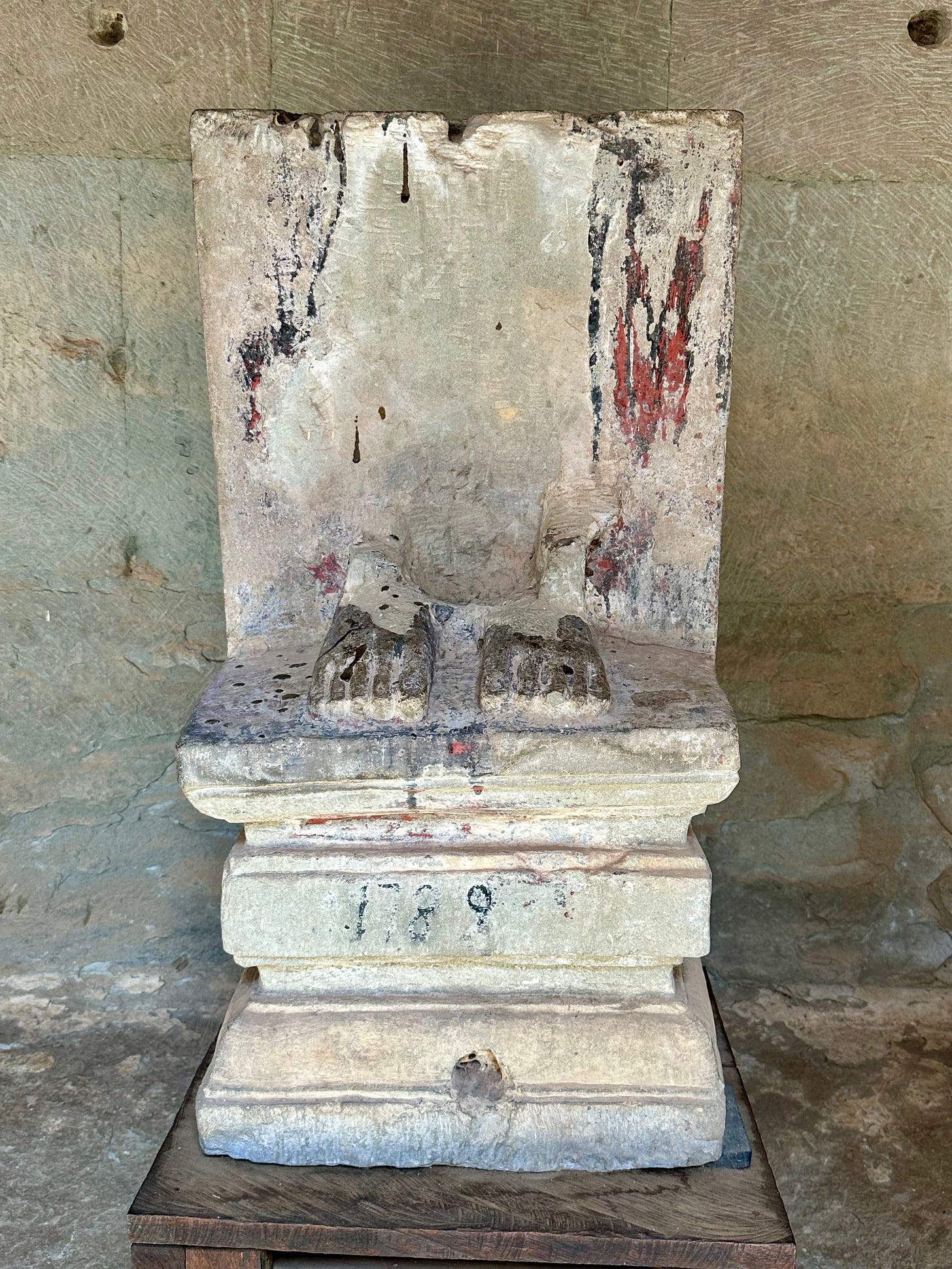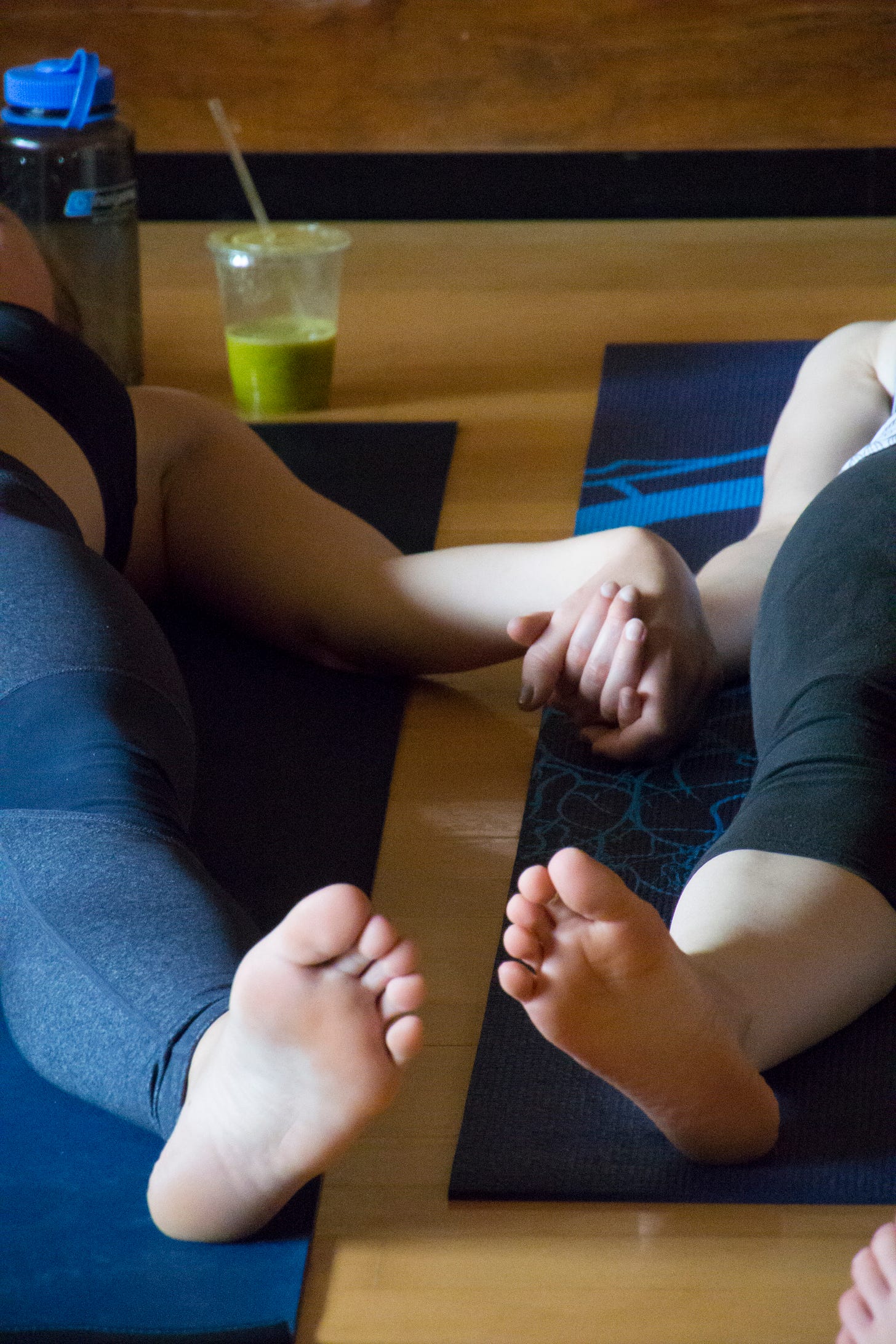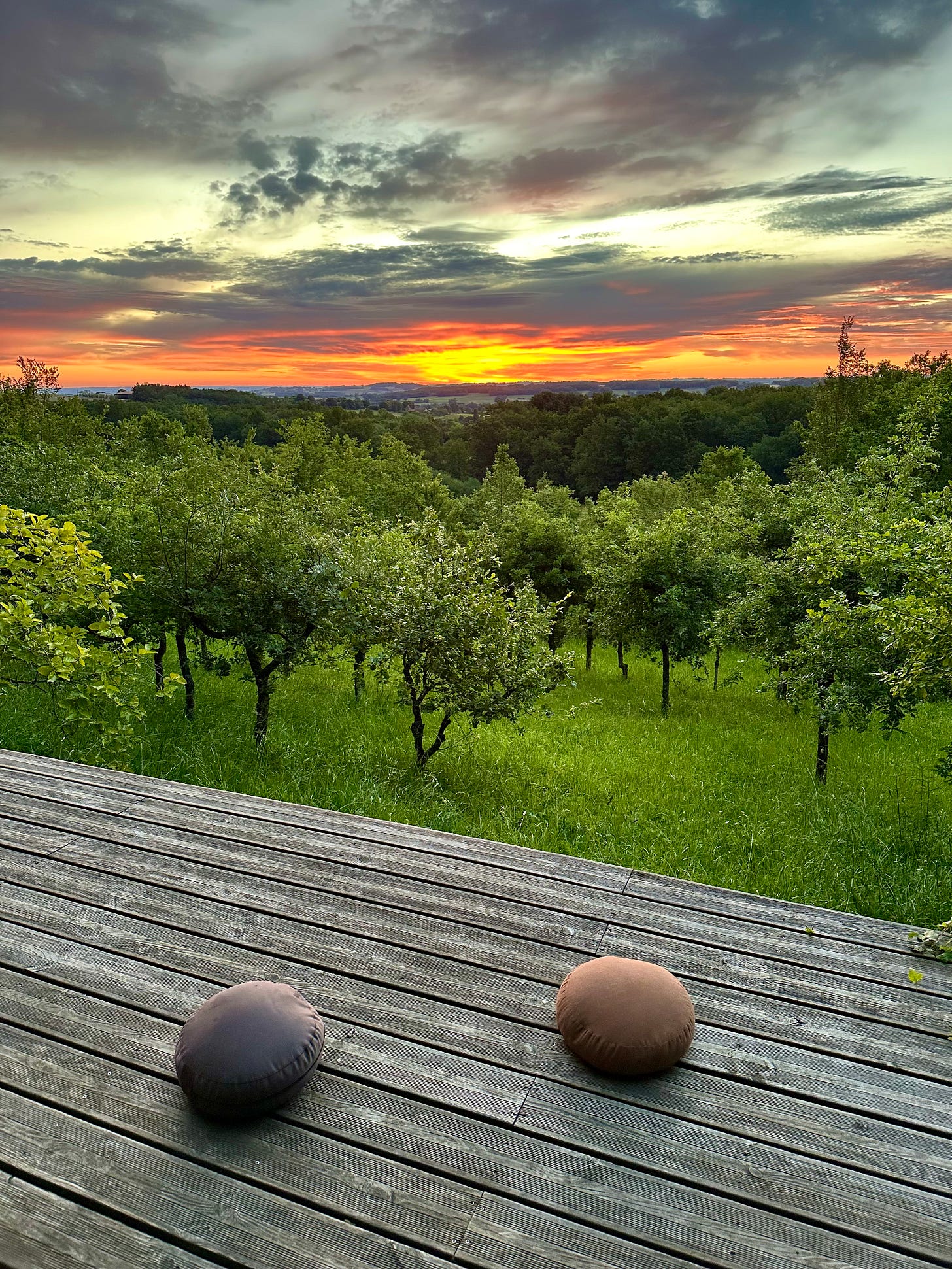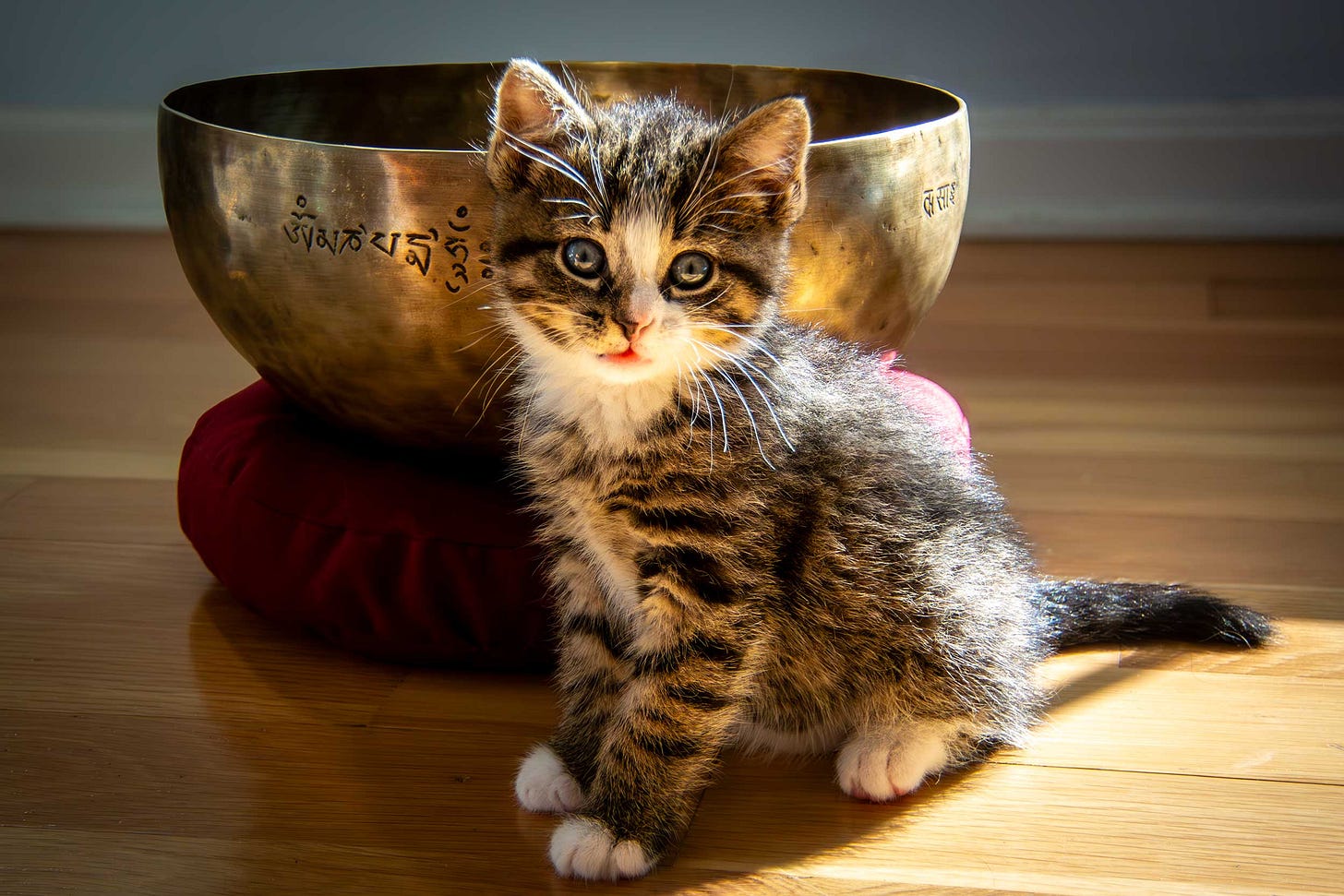Krishna’s Butterball in Mahabalipuram, Tamil Nadu, India
How are you feeling, dear friends? Stressed? Anxious? Concerned? On edge? Afraid? Let me assure you that you not alone.
In moments like this — when the world starts spinning, and the pulse quickens, and the breath grows rapid and shallow, and a sense of dread gathers in the belly, and it feels like the rock that, lo these many years, has perched precariously on top of the hill, might come tumbling down — I remember my practice of mindfulness. Did you know that in the ancient languages of India, the word for “mindfulness” (“smrti” in Sanskrit, “sati” in Pali), meant (amongst other things) “to remember”? Mindfulness is a practice of remembering to come back to the present moment, the only moment there is. It is also a practice of remembering why we practice — to transform pain and suffering into happiness and joy — and then remembering to practice the practices that help us to do this.
Mindfulness does not mean sitting in perfect stillness with a blank mind. It means noticing when the mind wanders off — to an uncertain future, perhaps — and then returning the attention to a chosen object of focus. Again and again. Practicing like this, over time you’ll train your attention to go more easily to where you want it to go: to the only moment there is, this moment, right here, right now. A moment full of possibility. A moment in which the conditions for transformation of suffering into happiness are already present, you only have to notice them.
To help you during this challenging time, here are a week’s worth of simple mindfulness practices. Consider these practices a mindfulness survival kit for concerned citizens, compassionate people, and democratic resisters who have a long road ahead.
Enjoy!
Monday: “Three Mindful Breaths”
Boudhanatha Stupa, Kathmandu, Nepal, on a very windy morning
The foundation of mindfulness is the breath. Learning to bring your attention back to the breath when it wanders off is a powerful mindfulness practice.
Start by noticing your posture. Whether you are standing, sitting, lying down, walking, doing yoga, etc., notice your body. Lengthen your spine, soften your abdomen, relax the muscles in your neck, jaw, chin, and shoulders. Assume a position that feels alive and fully awake.
Now notice your breath. Notice where it goes in the body. Notice if it is fast or slow, hot or cold, long or short. Find a place in your body where the breath feels present to you — maybe it’s the rise and fall of the abdomen, or the chest, or the tingle of the air on your lips and nose — and feel the breath as it enlivens your body.
Now, take three easy, conscious breaths. On the inhale, say to yourself:
Breathing in, I know that I’m breathing in.
And on the exhale, say to yourself:
Breathing out, I know I’m breathing out.
If that’s all the time you have, stop there. Sometimes it only takes three mindful breaths to change your day!
If you’d like to continue, take three more easy, conscious breaths. On the inhale, say to yourself:
Breathing in, I feel a sense of calm.
And on the exhale, say to yourself,
Breathing out, I feel a sense of ease.
As you do this, allow some of the tension you might still be holding in your shoulders and neck and face to relax away.
Finally, take three more easy, conscious breaths. On the inhale, say to yourself,
Breathing in, I am here.
And on the exhale, say to yourself,
Breathing out, I am home.
Because you are—you are here in this moment, and it is your home. Dwelling in the present moment, see if you can notice some of the conditions that also make it a happy moment, for even when there is suffering, there is also joy.
Return to this practice whenever it is helpful!
Tuesday: “Foot, Foot”
Relief in Angkor Wat, Siem Reap, Cambodia (my photograph from December 2023)
Noticing your body, in particular its connection to the earth, is a powerful mindfulness practice for returning to the present moment when the mind begins to doomscroll.
For this practice, sit in a chair or on another surface that allows you to place your feet on the earth.
Sit up tall, with a long spine and an open heart. If you notice tension in your shoulders or your neck, allow the muscles to relax. If you are clinching your jaw or making fists with your hands, allow this tension to release.
Bring your awareness to the soles of your feet. Notice all the places where your feet have contact with the earth. If you’re wearing socks, notice the feeling of the fabric against your skin.
If your mind wanders off, gently bring it back to the soles of the feet.
Try shifting your weight into your heels, and notice that sensation. Now, shift your weight into the balls of the feet and lift your heels. Allow your heels to return to the earth. Try lifting, and spreading, your toes. Let your toes return to the earth. Just notice the sensations in your feet.
Again, if your mind wanders off, gently bring it back to the soles of the feet.
Feel the connection between your feet and the earth grounding you to this moment. When the mind wanders off, remember this feeling of grounding.
As you focus on the contact between your feet and the earth, can you imagine that the earth is rising up to catch you, and to hold you up? Notice how the earth provides us with constant support, even when we don’t ask for it. And allow yourself to relax a little bit into that support.
After a minute or two of this practice, you can go back to your day. Feel free to come back to this practice whenever you need to feel a sense of grounding, and support!
Wednesday: “Walking Gratefully”
Makutabandhana Stupa, Kushinagar, India
In moments of fear and stress, it can seem like everything is wrong — that everything is bad. But that’s simply not true. Mindfulness practice is a reminder that even when things are bad, there is also good in the world, and in our lives. Even when things seem to go wrong, there are still many things that we are getting right. Even in the midst of great suffering, the conditions for the transformation of that suffering into happiness are present — we simply need to get better at noticing them.
The question becomes, how do we remember this? And how do we notice what is good and affirming?
One answer is gratitude.
I wrote a book called The Art of Gratitude, and in doing so I learned that gratitude is one of the most powerful and life-giving emotions. To feel gratitude is to notice what in your life sustains and supports you. Noticing, and then remembering, these things is vital to keeping the warm hearth of compassion and caring burning and not burning out.
For this practice, I invite you to take a gratitude walk. You don’t need much space to do this. You can walk indoors, so long as you have a clear path in front of you to take a few steps, stop, turn around, and begin again. You can also do this outside, feeling the support of the trees.
Stand tall. Notice your breath. Shift your awareness to the soles of your feet. Think of something you are grateful for. Take a step. Notice the sensation of picking the foot up and placing it down. Think of something else you are grateful for. Take another step. And so on. Say to yourself, I am grateful for… Step. Repeat.
Walk like this for a minute or two, and notice if you feel any more grounded and alive. Feel free to return to this practice anytime you feel like you’re stuck in the mud, and you can no longer see the lotus flower!
Thursday: “Drink Your Tea”
Our home pour-over coffee stand. Calligraphy created especially for me by Plum Village nuns; reads “sati,” mindfulness, in Pali.
Mindfulness teachers often speak about formal and informal practice. Formal practice is when you sit down with the intention of practicing mindful breathing (or another mindfulness practice). Informal practice is when you bring mindfulness into all aspects of your day.
Thich Nhat Hanh said that the essence of mindfulness is to “drink your tea” (for me, a coffee lover, it’s drink your coffee!). By this Thay means to focus fully on whatever activity you are doing. If the mind wanders away from the present moment, bring it back to what you are doing right now. Mindfulness means when you are cooking dinner, cook dinner. When you are listening to a friend, really listen. When you are driving, drive. When you are laughing, laugh with your whole being.
Today, I invite you to choose one or more of your daily activities, and to bring mindfulness into them. If you’re feeling down, choose an activity that you normally enjoy, though you can also do this for a neutral activity or one you dislike. Put your phone down, turn off your screens, and simply do whatever it is you are doing with your entire focus and attention. If the mind wanders off, bring it back to the activity at hand.
And then notice if the quality of the activity changes. And if you feel a little more at home in the moment, and in your life.
Friday: “Call a Friend”
Friends holding hands in savasana after our first Yoga Lab class in 2016
Popular mindfulness apps make it easy to practice: just pop in your ear buds, turn on a recording, and go. This is wonderful in many ways. The drawback is that it transforms mindfulness into a solitary activity, reinforcing a sense of isolation that is already too strong in our culture.
For much of its history, people did not practice mindfulness alone. They practiced in community, in sangha. When we practice together, we can support each other when things get difficult. We can hold each other up when we get stuck. Practicing together, it quickly becomes clear that none of us are alone — we are all in this together.
Today’s mindfulness practice is to reach out to a friend or family member who you like and who you haven’t talked to in a while. Maybe it’s someone you thought of while practicing walking gratefully earlier this week. I’d recommend that you call or video chat, rather than texting or chatting on social media (though of course you can reach out to them first by text to set up a time to talk, if that is your custom). Or go see them in person (that’s best, but not always possible). Hearing the voice, and seeing the face, of your friend is important, as is seeing them smile.
Ring with no agenda rather than to catch up. When you are on the call, practice being on the call, not multi-tasking, not rushing off to something else, not daydreaming. If you find your mind wandering off, remember to bring it back to the call. Practice listening with all your attention, and sharing with all your heart.
When the call is over, take a moment to just breathe and be before returning to your day.
Connecting to others is essential to our own well-being. It’s also essential to democracy. Indeed, community is the bedrock of democracy, so these calls are gentle, loving acts of resistance to those who wish to create a world of hate and division.
Saturday: “A Morning of Mindfulness”
Sunrise on Thich Nhat Hanh’s deck, Upper Hamlet, Plum Village (two cushions for me and my dearest love Sunny)
Every Saturday I practice a morning of mindfulness. I shut down my screens, unplug from the news, sign out of social media, tune out the noise and the echo chambers. I commit only to do things that bring me joy and help me feel more alive, awake, and fully present in my life. I commit not to “be productive,” in the sense of “keeping busy” or doing something that society deems “valuable” because its worth can be measured in dollars. I commit to doing things that I enjoy, even if our culture says I am “wasting time” (what a weird phrase!).
Today, I invite you to join me.
Set aside a few hours this morning, say from 9am-noon, to simply be. If you enjoy drinking tea, drink tea; while you are drinking your tea, really drink it, with your whole being.
Here are a few of the activities I often do. Make your own list, and then enjoy your morning of mindfulness!
Breathe mindfully
Go for a mindful walk with my amazing wife Sunny
Play with my cats
Cook a healthy meal
Write a poem
Resist enemyship
Call a friend I haven’t spoken to in a while
Sit in a coffee shop and just drink my coffee
Watch the birds
Say a kind word to a stranger
Play cards or a board game
Work on my bonsai trees
Listen to a record all the way through
Make a pot of matcha and really savor it
Smile
Do yoga
Read a book not for research or work but for pleasure
Laugh
Sunday: “A Mindfulness Bell”
Vrtti as a kitten. He’s one of my mindfulness bells. Photo by Anna Sunderland Engels.
Mindfulness is a practice of remembering to come back to the present moment, and to return to the practices you’ve learned when they are helpful. But sometimes the hardest thing to remember is to remember.
At Plum Village, Thich Nhat Hanh’s monastery in France, every time a bell or a clock rings, everyone stops whatever they are doing and takes three mindful breaths to return to the present.
When I practice and teach yoga, every time I bring my hands to heart center, it’s a mindfulness bell. At the university, every time someone knocks on my office door it’s a mindfulness bell. At home, every time our cat Vrtti trills (yes, he’s a musical cat, he doesn’t meow, he sings!), and every time our cat Citta comes near me and somersaults, asking to be petted, it’s a mindfulness bell.
Today, I invite you to identify something in your life that can serve as a reminder to practice mindfulness. What’s your mindfulness bell?













This was much needed and full of incredible reminders. Grateful for you, Jeremy!
Thanks for this wonderful collection of mindfulness practices, Jeremy. A great gift in these challenging times. 🙏